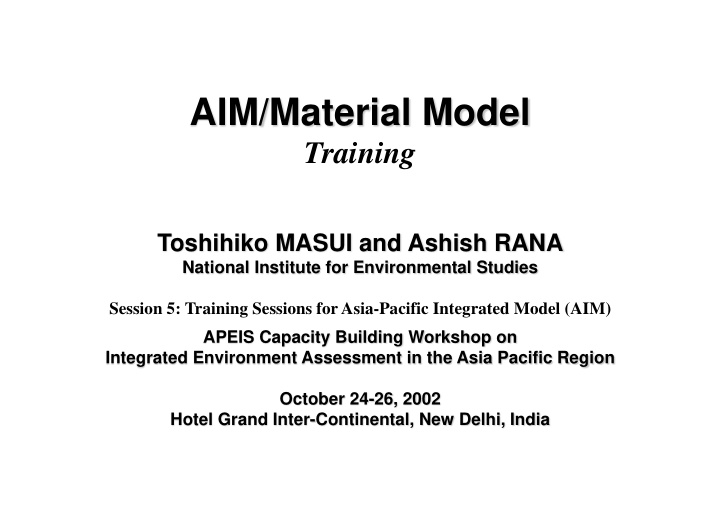



AIM/Material Model Training Toshihiko MASUI and Ashish RANA National Institute for Environmental Studies Session 5: Training Sessions for Asia-Pacific Integrated Model (AIM) APEIS Capacity Building Workshop on Integrated Environment Assessment in the Asia Pacific Region October 24-26, 2002 Hotel Grand Inter-Continental, New Delhi, India
Coverage in this workshop • Summary (Session 4) For understanding AIM/Material model – What is AIM/Material model? – Model formulation – Necessary data for simulation – Future scenario • Training (This session) – Operation of AIM/Material model • Application (Session 7) – Application of AIM/Material model to India and Japan
Contents of this session 1. Model components See Chap. 2 & 3 2. Model code Chap. 1, Appendix 1 & 2 3. Dataset Appendix 3 4. Demonstration of model run Chap. 4
Structure of AIM/Material endogenous produced and imported commodity domestic supply goods are integrated. PS(I) fixed commodity household SUP_D(I) SUP_M(I) physical exported domestic imported unit produced goods are goods supply goods sector PEX(I) PDM(I) PIM(I) shared export and domestic. final demand DIS_X(I) DIS_D(I) hypothetical sector household Endowment produced produced ... flow goods PY(1) goods PY(I) production sector PRO(J) CO2 pollution PCARB energy intermediate capital labor recycled generation PK(J,”prd”) PL input PR(P) PS(E) input PS(N) PX(J,P) government pollution management sector POL(J,P) CO2 energy intermediate env. capital labor discharge household PCARB PS(E) input PS(N) PK(J,P) PL PZ(P) household government
Structure of AIM/Material (cont.) production sector production sector pollution management sector pollution management sector production sector labor PL CO2 PCARB import capital PIM(I) PK(J,S) discharge PZ(P) stock change transfer between PS(I) household & government PT export PEX(I) endogenous household HUS government GOV commodity fixed household government investment commodity consumption consumption goods PI goods PCH goods PCG physical unit aggregation of aggregation of aggregation of household consumption investment government sector FCH goods IVA consumption FCG CO2 final demand PCARB investment government household household hypothetical sector demand demand energy demand demand except PS(N) PS(N) PS(E) energy PS(N) Endowment flow production sector
Recommend
More recommend